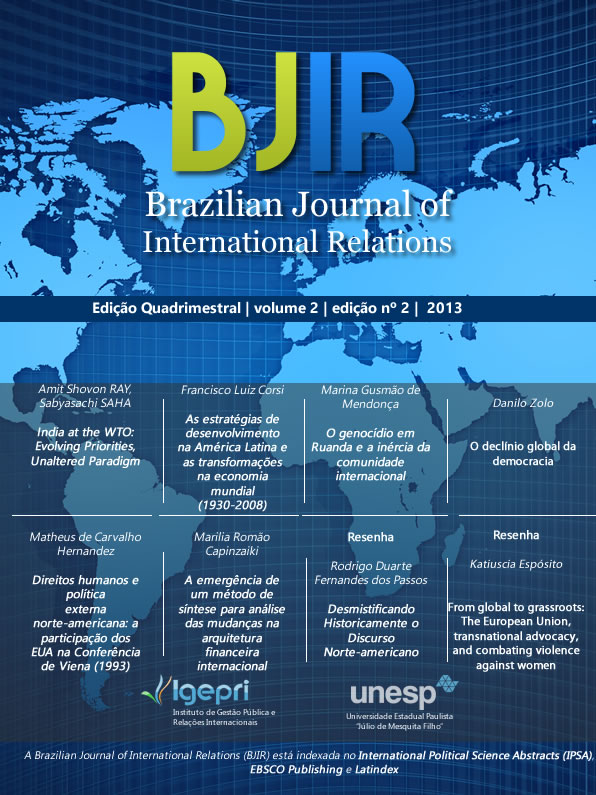O genocídio em Ruanda e a inércia da comunidade internacional / Rwanda genocide and the inaction of the international community
DOI:
https://doi.org/10.36311/2237-7743.2013.v2n2.p300-328Resumen
Entre abril e julho de 1994, o mundo assistiu impassível ao extermínio de mais de 800.000 pessoas em Ruanda. Tal morticínio é considerado o terceiro maior ocorrido desde 1950, comparável apenas àqueles verificados no Cambodja e em Bangladesh, na década de 1970. Entretanto, no caso de Ruanda, há um dado assustador: por ocasião da matança, a população do país era de aproximadamente 7.500.000 habitantes, sendo 6.300.000 hutus, 1.100.000 tutsis e 100.000 pigmeus. Isto significa que cerca de 11% dos ruandeses e ¾ da população tutsi foram eliminados em apenas um trimestre. A comunidade internacional nada fez para evitar a matança. Pelo contrário: além de não intervir diretamente, a Organização das Nações Unidas (ONU) reduziu drasticamente o contingente da força de paz que mantinha em Ruanda, a despeito das advertências do General Roméo Alain Dallaire, comandante das tropas da UNAMIR, de que a tragédia estava a caminho. Passado o estupor provocado pelo genocídio, restou o problema fundamental da reconstrução do país. A esse respeito, é preciso assinalar as precaríssimas condições econômicas da região, o que é agravado pelo estraçalhamento do tecido social durante a matança. Ademais, não podemos esquecer que, se em 1994, o mundo assistiu passivamente à dilaceração de Ruanda, agora poucos estão preocupados com as dificuldades de reconstrução de um lugar que não tem importância estratégica e não dispõe de grandes riquezas naturais.Os fatores que levaram ao genocídio em Ruanda e a inércia da comunidade internacional para impedir o massacre são os temas deste artigo.
Between April and July 1994 the world seemed not affected by the extermination of more than 800.000 people in Rwanda. This is the third largest massacre since 1950 and can only be compared to those occurred in Cambodia and Bangladesh in the1970’s. But in the case of Rwanda there is something truly alarming: at the time of the genocide there were about 7.500.000 inhabitants in the country; 6.300.000 Hutus; 1.100.000 Tutsis; and 100.000 pigmies, what means that about 11% of Rwandans and ¾ of the Tutsi population were killed in a period of three months.
The international community did nothing to avoid the massacre, and the United Nations (UN) even reduced its peacekeepers in Rwanda despite Roméo Alain Dallaire, the general commander of the UNAMIR troops in the country, having warned about the tragedy to come.In the aftermath of the world’s astonishment with the genocide the fundamental task is the problem of country’s reconstruction under very difficult economic conditions remained, now exacerbated by the social laceration it provoked. In addition, it cannot be forgotten that if in 1994 the world did nothing to avoid the massacre, nowadays there are still very few people worried about the reconstruction of a place poor in natural resources.The article analyses the conditions that conducted to Rwanda’s genocide and the inaction of the international community to avoid it.







